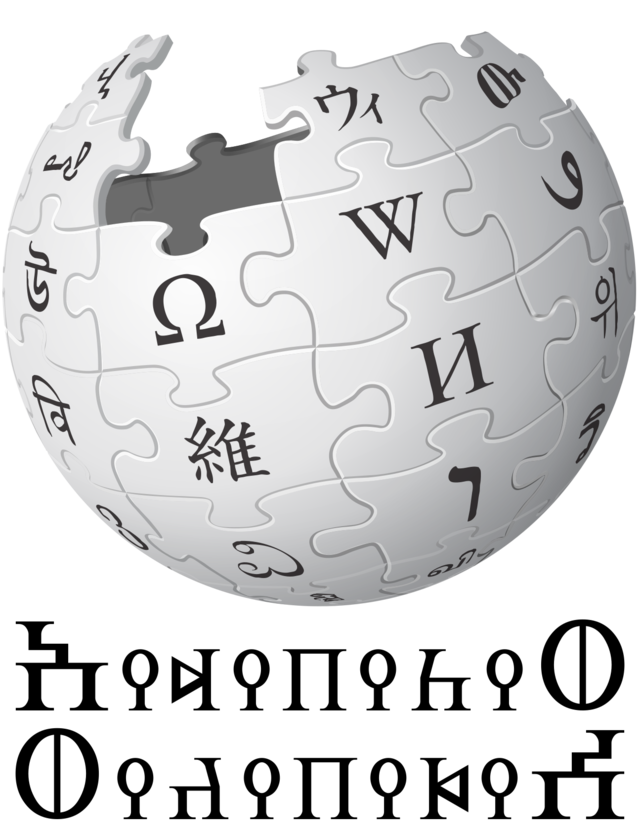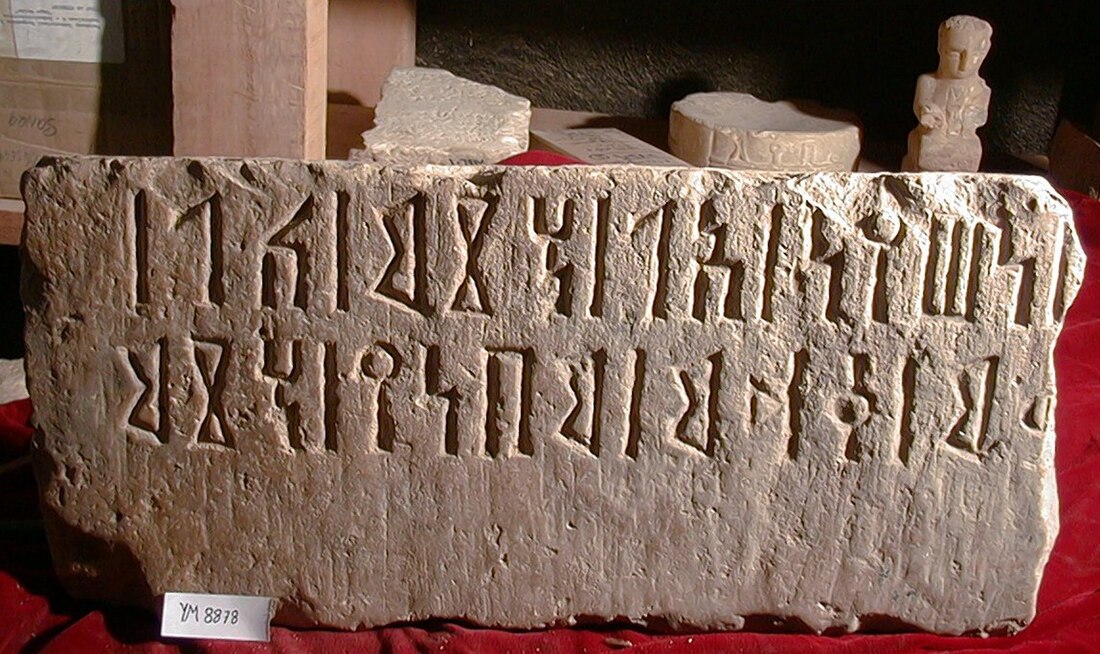The Ancient South Arabian script (Old South Arabian: 𐩣𐩯𐩬𐩵 ms3nd; modern Arabic: الْمُسْنَد musnad) branched from the Proto-Sinaitic script in about the late 2nd millennium BCE. It was used for writing the Old South Arabian languages Sabaic, Qatabanic, Hadramautic, Minaean Hasaitic, and Geʽez in Dʿmt. The earliest instances of the Ancient South Arabian script are painted pottery sherds from Raybun in Hadhramaut in Yemen, which are dated to the late 2nd millennium BCE.[3] There are no letters for vowels, though some can be indicated via matres lectionis.
This article's lead section contains information that is not included elsewhere in the article. (March 2019) |
| Ancient South Arabian script | |
|---|---|
 | |
| Script type | |
Time period | Late 2nd millennium BCE to 6th century CE |
| Direction | Right-to-left script |
| Languages | Old South Arabian, Ge'ez |
| Related scripts | |
Parent systems | Egyptian hieroglyphs
|
Child systems | Geʽez[1][2] |
Sister systems | Ancient North Arabian |
| ISO 15924 | |
| ISO 15924 | Sarb (105), Old South Arabian |
| Unicode | |
Unicode alias | Old South Arabian |
| U+10A60–U+10A7F | |

Its mature form was reached around 800 BCE and its use continued until the 6th century CE, including Ancient North Arabian inscriptions in variants of the alphabet, when it was displaced by the Arabic alphabet.[4] In Eritrea and Ethiopia, it evolved later into the Geʽez script,[1][2] which, with added symbols throughout the centuries, has been used to write Amharic, Tigrinya and Tigre, as well as other languages (including various Semitic, Cushitic, Omotic, and Nilo-Saharan languages).
Properties
- It is usually written from right to left but can also be written from left to right. When written from left to right the characters are flipped horizontally (see the photo).
- The spacing or separation between words is done with a vertical bar mark (|).
- Letters in words are not connected together.
- It does not implement any diacritical marks (dots, etc.), differing in this respect from the modern Arabic alphabet.
Characteristics
Difference from the Arabic script
The Musnad script differs from the Arabic script, which most linguists believe developed from the Nabataean script in the fourth century AD, which in turn developed from the Aramaic script. The languages of the Southern Musnad script also differ greatly from the Northern Arabic language,in terms of script, lexicon, grammar, styles, and perhaps sounds, and the letters of the script increase. The Musnad is derived from Arabic with one sibilant letter (some call it samikh) or the third sīn.[5][6]
Letters


| Letter[7] | Phoneme | IPA | Corresponding letter in | ||||||||
|---|---|---|---|---|---|---|---|---|---|---|---|
| Ancient North Arabian | Ge'ez | Phoenician | Aramaic | Arabic | Hebrew | ||||||
| 𐩠 | h | [h] | 𐪀 | ሀ | 𐤄 | 𐡄 | ه | ה | |||
| 𐩡 | l | [l] | 𐪁 | ለ | 𐤋 | 𐡋 | ل | ל | |||
| 𐩢 | ḥ | [ħ] | 𐪂 | ሐ | 𐤇 | 𐡇 | ح | ח | |||
| 𐩣 | m | [m] | 𐪃 | መ | 𐤌 | 𐡌 | م | מ ם | |||
| 𐩤 | q | [q] | 𐪄 | ቀ | 𐤒 | 𐡒 | ق | ק | |||
| 𐩥 | w | [w], [uː] | 𐪅 | ወ | 𐤅 | 𐡅 | و | ו | |||
| 𐩦 | s² (š) | [ɬ] | 𐪆 | ሠ | 𐤔 | 𐡔 | ش | ש | |||
| 𐩧 | r | [r] | 𐪇 | ረ | 𐤓 | 𐡓 | ر | ר | |||
| 𐩨 | b | [b] | 𐪈 | በ | 𐤁 | 𐡁 | ب | ב | |||
| 𐩩 | t | [t] | 𐪉 | ተ | 𐤕 | 𐡕 | ت | ת | |||
| 𐩪 | s¹ (s) | [s] | 𐪊 | ሰ | س | ||||||
| 𐩫 | k | [k] | 𐪋 | ከ | 𐤊 | 𐡊 | ك | כ ך | |||
| 𐩬 | n | [n] | 𐪌 | ነ | 𐤍 | 𐡍 | ن | נ ן | |||
| 𐩭 | ḫ | [x] | 𐪍 | ኀ | خ | ||||||
| 𐩮 | ṣ | [sˤ] | 𐪎 | ጸ | 𐤑 | 𐡑 | ص | צ ץ | |||
| 𐩯 | s³ (ś) | [s̪] | 𐪏 | 𐤎 | 𐡎 | ס | |||||
| 𐩰 | f | [f] | 𐪐 | ፈ | 𐤐 | 𐡐 | ف | פ ף | |||
| 𐩱 | ʾ | [ʔ] | 𐪑 | አ | 𐤀 | 𐡀 | ا | א | |||
| 𐩲 | ʿ | [ʕ] | 𐪒 | ዐ | 𐤏 | 𐡏 | ع | ע | |||
| 𐩳 | ḍ | [ɬˤ] | 𐪓 | ፀ | ض | ||||||
| 𐩴 | g | [g] | 𐪔 | ገ | 𐤂 | 𐡂 | ج | ג | |||
| 𐩵 | d | [d] | 𐪕 | ደ | 𐤃 | 𐡃 | د | ד | |||
| 𐩶 | ġ | [ɣ] | 𐪖 | غ | |||||||
| 𐩷 | ṭ | [tˤ] | 𐪗 | ጠ | 𐤈 | 𐡈 | ط | ט | |||
| 𐩸 | z | [z] | 𐪘 | ዘ | 𐤆 | 𐡆 | ز | ז | |||
| 𐩹 | ḏ | [ð] | 𐪙 | ذ | |||||||
| 𐩺 | y | [j], [iː] | 𐪚 | የ | 𐤉 | 𐡉 | ي | י | |||
| 𐩻 | ṯ | [θ] | 𐪛 | ث | |||||||
| 𐩼 | ẓ | [θˤ] | 𐪜 | ظ | |||||||

Numbers
Six signs are used for numbers:
| 1 | 5 | 10 | 50 | 100 | 1000 |
|---|---|---|---|---|---|
| 𐩽 | 𐩭 | 𐩲 | 𐩾 | 𐩣 | 𐩱 |
The sign for 50 was evidently created by removing the lower triangle from the sign for 100.[8] The sign for 1 doubles as a word separator. The other four signs double as both letters and numbers. Each of these four signs is the first letter of the name of the corresponding numeral.[8]
An additional sign (𐩿) is used to bracket numbers, setting them apart from surrounding text.[8] For example, 𐩿𐩭𐩽𐩽𐩿
These signs are used in an additive system similar to Roman numerals to represent any number (excluding zero). Two examples:
- 17 is written as 1 + 1 + 5 + 10: 𐩲𐩭𐩽𐩽
- 99 is written as 1 + 1 + 1 + 1 + 5 + 10 + 10 + 10 + 10 + 50: 𐩾𐩲𐩲𐩲𐩲𐩭𐩽𐩽𐩽𐩽
| 1 | 2 | 3 | 4 | 5 | 6 | 7 | 8 | 9 | 10 |
|---|---|---|---|---|---|---|---|---|---|
| 𐩽 | 𐩽𐩽 | 𐩽𐩽𐩽 | 𐩽𐩽𐩽𐩽 | 𐩭 | 𐩭𐩽 | 𐩭𐩽𐩽 | 𐩭𐩽𐩽𐩽 | 𐩭𐩽𐩽𐩽𐩽 | 𐩲 |
| 11 | 12 | 13 | 14 | 15 | 16 | 17 | 18 | 19 | 20 |
| 𐩲𐩽 | 𐩲𐩽𐩽 | 𐩲𐩽𐩽𐩽 | 𐩲𐩽𐩽𐩽𐩽 | 𐩲𐩭 | 𐩲𐩭𐩽 | 𐩲𐩭𐩽𐩽 | 𐩲𐩭𐩽𐩽𐩽 | 𐩲𐩭𐩽𐩽𐩽𐩽 | 𐩲𐩲 |
Thousands are written two different ways:
- Smaller values are written using just the 1000 sign. For example, 8,000 is written as 1000 × 8: 𐩱𐩱𐩱𐩱𐩱𐩱𐩱𐩱
- Larger values are written by promoting the signs for 10, 50, and 100 to 10,000, 50,000, and 100,000 respectively:
- 31,000 is written as 1000 + 10,000 × 3: 𐩲𐩲𐩲𐩱 (easily confused with 1,030)
- 40,000 is written as 10,000 × 4: 𐩲𐩲𐩲𐩲 (easily confused with 40)
- 253,000 is written as 2 × 100.000 + 50.000 + 3 × 1000: 𐩣𐩣𐩾𐩱𐩱𐩱 (easily confused with 3,250)
Perhaps because of ambiguity, numerals, at least in monumental inscriptions, are always clarified with the numbers written out in words.
Zabūr

Zabūr, also known as "South Arabian minuscules",[9] is the name of the cursive form of the South Arabian script that was used by the Sabaeans in addition to their monumental script, or Musnad.[10]
Zabur was a writing system in ancient Yemen along with Musnad. The difference between the two is that Musnad documented historical events, meanwhile Zabur writings were used for religious scripts or to record daily transactions among ancient Yemenis. Zabur writings could be found in palimpsest form written on papyri or palm-leaf stalks.[11][12]
Unicode
The South Arabian alphabet was added to the Unicode Standard in October, 2009 with the release of version 5.2.
The Unicode block, called Old South Arabian, is U+10A60–U+10A7F.
Note that U+10A7D OLD SOUTH ARABIAN NUMBER ONE (𐩽) represents both the numeral one and a word divider.[8]
| Old South Arabian[1] Official Unicode Consortium code chart (PDF) | ||||||||||||||||
| 0 | 1 | 2 | 3 | 4 | 5 | 6 | 7 | 8 | 9 | A | B | C | D | E | F | |
| U+10A6x | 𐩠 | 𐩡 | 𐩢 | 𐩣 | 𐩤 | 𐩥 | 𐩦 | 𐩧 | 𐩨 | 𐩩 | 𐩪 | 𐩫 | 𐩬 | 𐩭 | 𐩮 | 𐩯 |
| U+10A7x | 𐩰 | 𐩱 | 𐩲 | 𐩳 | 𐩴 | 𐩵 | 𐩶 | 𐩷 | 𐩸 | 𐩹 | 𐩺 | 𐩻 | 𐩼 | 𐩽 | 𐩾 | 𐩿 |
Notes
| ||||||||||||||||
In modern culture
Yemeni archeologist and linguist Mutaher al-Eryani, was keen to record a memorial in the Musnad script and in the Sabaean language, commemorating the renovation of the Ma’rib Dam in 1986, which was carried out at the expense of Sheikh Zayed and in conjunction with the celebration of victory in the North Yemen Civil War against the Kingdom of Yemen. The inscription was published in a scientific article written by the Frenchman Christian Robin as the last official Musnad inscription.[13]
Gallery
- Photos from National Museum of Yemen:
- Photos from Yemen Military Museum:
- Photo from the British Museum
- Incense burner, from Yemen, 5th-4th century BCE. An ancient South Arabian inscription about the names of incense
See also
- Ancient North Arabian script
- Arabist and archeologist Eduard Glaser
- Geographer Carl Rathjens
- Paleo-Arabic
References
References
External links
Wikiwand in your browser!
Seamless Wikipedia browsing. On steroids.
Every time you click a link to Wikipedia, Wiktionary or Wikiquote in your browser's search results, it will show the modern Wikiwand interface.
Wikiwand extension is a five stars, simple, with minimum permission required to keep your browsing private, safe and transparent.















